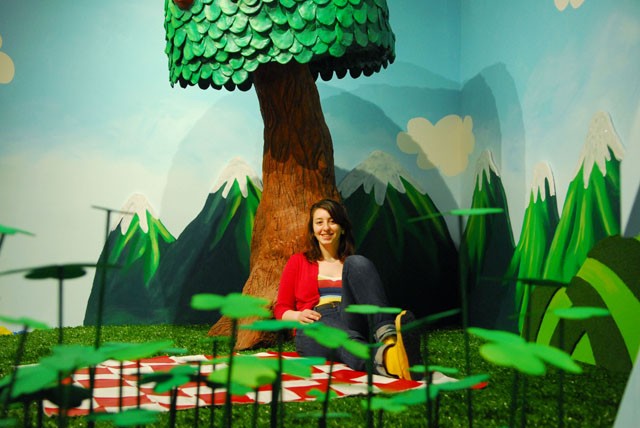What: âÄúinterpenetrationâÄù MFA Thesis Exhibition
When: Now until May 20
Where: Katherine E.Nash Gallery, 405 21st Avenue S., Minneapolis
Cost: Free
It took five days, two hired hands, the generous help of friends and a forklift to install Robin SchwartzmanâÄôs vibrant, highly interactive piece in the Katherine E. Nash Gallery. The set looks something like a cartoon version of a McDonaldâÄôs play place brought to life, minus the crying kids and the maximum height limit.
Guests are invited to take off their shoes and come sit in the grass under the tree, ride down the slide, or jump into the pool of 6,000 plastic balls courtesy of an expired HardeeâÄôs.
The piece is part of the MFA Thesis Exhibition titled âÄúinterpenetrationâÄù featuring the final work of six soon-to-be alumni of the University of MinnesotaâÄôs graduate art program.
âÄúSo these six students âÄî âÄù gallery director Howard Oransky said, stopping abruptly mid-sentence to re-evaluate the mispronounced label. âÄúWe should really be referring to them as artists now. TheyâÄôre just completing that transition from students into professional artists.âÄù
SchwartzmanâÄôs transition has been an evolving process facilitated by the depth of the UniversityâÄôs graduate program. In fact, as a freshman she never wouldâÄôve guessed that her masterâÄôs thesis piece would end up an interactive wonderland.
âÄúI came in for printmaking, actually. Over the past three years IâÄôve just kind of evolved using the resources that are here,âÄù Schwartzman said while sitting in her pool of plastic balls. âÄúIâÄôm really interested in the gallery not being this place where people canâÄôt touch art and have to look at the wall. I want people to have fun when they come to openings and interact and really be part of the work.âÄù
Though the piece may seem more fit to accompany Happy Meals than the collection of dark pencil interpretations of Franz KafkaâÄôs works directly to its right, SchwartzmanâÄôs work challenges standard gallery etiquette and asserts itself with a genuine nonconventional appeal.
âÄúThe Katherine Nash Gallery is our laboratory for the investigation and discovery of visual art, its possibilities and its meanings,âÄù Oransky said. âÄúYou might not see work like [RobinâÄôs] in an art history book, but in a sense sheâÄôs creating her own personal language as an artist.âÄù
Fellow thesis exhibitor Ethan Rowan Pope looked to literature to draw his own language.
âÄúMy momâÄôs a poet. My dadâÄôs a screenwriter. Our whole family has always been very much influenced by literature,âÄù he said.
That influence is on display at the Nash Gallery with PopeâÄôs pencil drawings interpreting prominent passages from several of Franz KafkaâÄôs most well-known stories. The ominous imagery almost swallows the radiance of SchwartzmanâÄôs jovial display, an accurate reflection of KafkaâÄôs grim tone.
âÄúI think what I like most about Kafka is not just the studied eloquence of his craft, but itâÄôs the inimitable personality of his writing,âÄù Pope said. âÄúHeâÄôs kind of paranoid and horrifying but heâÄôs also distinctly funny.âÄù
Though KafkaâÄôs black humor may not translate through PopeâÄôs drawings, they manage to capture the sense of helplessness and despair that has fed generations of Kafka enthusiasts. The drawings are absent of color, but wielding a skillful pencil, Pope shades his interpretations of the pitiful worlds Kafka added to our own in his work.
âÄúI thought that pencil would be the best way to describe the darkness and harshness of KafkaâÄôs realities,âÄù he said.
The ironic juxtaposition of Schwartzman and PopeâÄôs works is reflective of the broad scope of the UniversityâÄôs graduate art program. Having been given the freedom to interpret visual art as a fluid term, these artists will be leaving the classroom and dropping their work into the sea of their craft.








